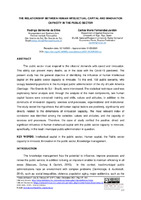| dc.creator | Silva, Rodrigo Belmonte Da | |
| dc.creator | Fernández Jardón, Carlos María | |
| dc.date.accessioned | 2022-09-20T19:47:07Z | |
| dc.date.available | 2022-09-20T19:47:07Z | |
| dc.date.issued | 2021-01-20 | |
| dc.identifier.citation | Silva, R. B. D., y Fernandez Jardón, C. M. (2021). The relationship between human intelectual capital and innovation capacity in the public sector. Revista Científica, Visión de Futuro. Posadas (Misiones): UNaM. FCE. APP; 25(2), 137-153. | es_AR |
| dc.identifier.issn | 1668-8708 (Versión online) | |
| dc.identifier.issn | 1669-7634 (Versión impresa) | |
| dc.identifier.other | VF-082 | |
| dc.identifier.uri | https://hdl.handle.net/20.500.12219/3677 | |
| dc.description | Fil: Silva, Rodrigo Belmonte Da. Federal Institute Farroupilha. Management and Business Axis; Brasil. | es_AR |
| dc.description | Fil: Fernández Jardón, Carlos María. University of Vigo. Department of Applied Economics; España. | |
| dc.description | Fil: Fernández Jardón, Carlos María. National Research University Higher School of Economics Perm, Russian Federation; Rusia. | |
| dc.description.abstract | The public sector must respond to the citizens’ demands with speed and innovation.
This ability can prevent many deaths, as in the case with the Covid-19 pandemic. The present study has the general objective of identifying the influence of human intellectual capital on the public sector capacity to innovate. To this end, 158 public servants, who occupy leadership positions in the municipal public administration of the city of Latin America (Santiago - Rio Grande do Sul - Brazil), were interviewed. The statistical technique used was exploratory factor analysis and, through the analysis of the main components, two human capital factors were extracted: training and skills, values and attitudes, in addition to the constructs of innovation capacity: services and processes, organizational and institutional. The study tested the hypothesis that all human capital factors are positively, significantly and directly related to the dimensions of innovation capacity. The most relevant index of correlation was identified among the variables: values and attitudes, and the capacity of services and processes. Therefore, the case of study verified the positive, direct and significant influence of human intellectual capital with the public sector capacity to innovate, specifically, in the local / municipal public administration in question. | es_AR |
| dc.format | application/pdf | |
| dc.format.extent | 446 KB | |
| dc.language.iso | eng | es_AR |
| dc.publisher | Universidad Nacional de Misiones. Facultad de Ciencias Económicas. Programa de Posgrado en Administración | es_AR |
| dc.relation | info:eu-repo/semantics/altIdentifier/doi/10.36995/j.visiondefuturo.2021.25.02R.004.en | |
| dc.relation | info:eu-repo/semantics/altIdentifier/urn/https://revistacientifica.fce.unam.edu.ar/index.php/visiondefuturo/issue/view/21 | |
| dc.rights | info:eu-repo/semantics/openAccess | |
| dc.subject | Intellectual capital in the public sector | en |
| dc.subject | Human capital | en |
| dc.subject | The public sector capacity to innovate | en |
| dc.subject | Innovation in the public sector | en |
| dc.subject | Knowledge management | en |
| dc.title | The relationship between human intelectual capital and innovation capacity in the public sector | en |
| dc.type | info:eu-repo/semantics/article | |
| dc.type | info:ar-repo/semantics/artículo | |
| dc.type | info:eu-repo/semantics/publishedVersion | |



